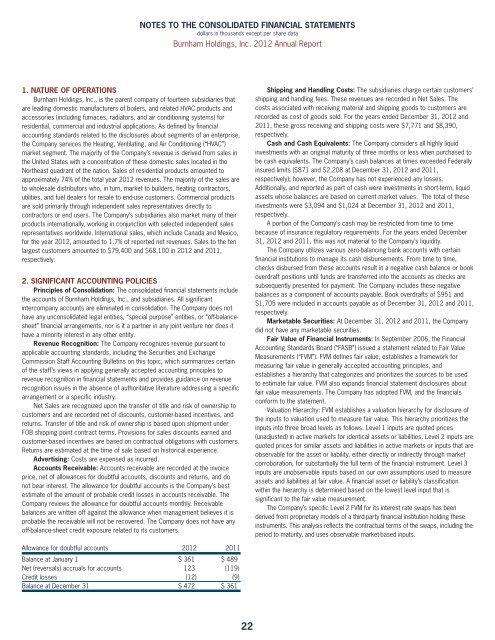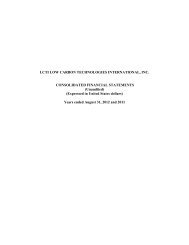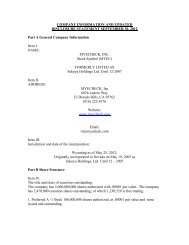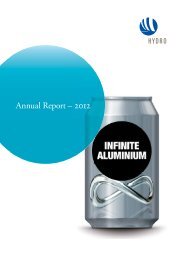Burnham Holdings, Inc.
Burnham Holdings, Inc.
Burnham Holdings, Inc.
You also want an ePaper? Increase the reach of your titles
YUMPU automatically turns print PDFs into web optimized ePapers that Google loves.
1. NATURE OF OPERATIONS<br />
<strong>Burnham</strong> <strong>Holdings</strong>, <strong>Inc</strong>., is the parent company of fourteen subsidiaries that<br />
are leading domestic manufacturers of boilers, and related HVAC products and<br />
accessories (including furnaces, radiators, and air conditioning systems) for<br />
residential, commercial and industrial applications. As defined by financial<br />
accounting standards related to the disclosures about segments of an enterprise,<br />
the Company services the Heating, Ventilating, and Air Conditioning (“HVAC”)<br />
market segment. The majority of the Company’s revenue is derived from sales in<br />
the United States with a concentration of these domestic sales located in the<br />
Northeast quadrant of the nation. Sales of residential products amounted to<br />
approximately 74% of the total year 2012 revenues. The majority of the sales are<br />
to wholesale distributors who, in turn, market to builders, heating contractors,<br />
utilities, and fuel dealers for resale to end-use customers. Commercial products<br />
are sold primarily through independent sales representatives directly to<br />
contractors or end users. The Company’s subsidiaries also market many of their<br />
products internationally, working in conjunction with selected independent sales<br />
representatives worldwide. International sales, which include Canada and Mexico,<br />
for the year 2012, amounted to 1.7% of reported net revenues. Sales to the ten<br />
largest customers amounted to $79,400 and $68,100 in 2012 and 2011,<br />
respectively.<br />
2. SIGNIFICANT ACCOUNTING POLICIES<br />
Principles of Consolidation: The consolidated financial statements include<br />
the accounts of <strong>Burnham</strong> <strong>Holdings</strong>, <strong>Inc</strong>., and subsidiaries. All significant<br />
intercompany accounts are eliminated in consolidation. The Company does not<br />
have any unconsolidated legal entities, “special purpose” entities, or “off-balancesheet”<br />
financial arrangements, nor is it a partner in any joint venture nor does it<br />
have a minority interest in any other entity.<br />
Revenue Recognition: The Company recognizes revenue pursuant to<br />
applicable accounting standards, including the Securities and Exchange<br />
Commission Staff Accounting Bulletins on this topic, which summarizes certain<br />
of the staff’s views in applying generally accepted accounting principles to<br />
revenue recognition in financial statements and provides guidance on revenue<br />
recognition issues in the absence of authoritative literature addressing a specific<br />
arrangement or a specific industry.<br />
Net Sales are recognized upon the transfer of title and risk of ownership to<br />
customers and are recorded net of discounts, customer-based incentives, and<br />
returns. Transfer of title and risk of ownership is based upon shipment under<br />
FOB shipping point contract terms. Provisions for sales discounts earned and<br />
customer-based incentives are based on contractual obligations with customers.<br />
Returns are estimated at the time of sale based on historical experience.<br />
Advertising: Costs are expensed as incurred.<br />
Accounts Receivable: Accounts receivable are recorded at the invoice<br />
price, net of allowances for doubtful accounts, discounts and returns, and do<br />
not bear interest. The allowance for doubtful accounts is the Company’s best<br />
estimate of the amount of probable credit losses in accounts receivable. The<br />
Company reviews the allowance for doubtful accounts monthly. Receivable<br />
balances are written off against the allowance when management believes it is<br />
probable the receivable will not be recovered. The Company does not have any<br />
off-balance-sheet credit exposure related to its customers.<br />
Allowance for doubtful accounts 2012 2011<br />
Balance at January 1 $ 361) $ 489)<br />
Net (reversals) accruals for accounts 123) (119)<br />
Credit losses (12) (9)<br />
Balance at December 31 $ 472) $ 361)<br />
NOTES TO THE CONSOLIDATED FINANCIAL STATEMENTS<br />
dollars in thousands except per share data<br />
<strong>Burnham</strong> <strong>Holdings</strong>, <strong>Inc</strong>. 2012 Annual Report<br />
22<br />
Shipping and Handling Costs: The subsidiaries charge certain customers’<br />
shipping and handling fees. These revenues are recorded in Net Sales. The<br />
costs associated with receiving material and shipping goods to customers are<br />
recorded as cost of goods sold. For the years ended December 31, 2012 and<br />
2011, these gross receiving and shipping costs were $7,771 and $8,390,<br />
respectively.<br />
Cash and Cash Equivalents: The Company considers all highly liquid<br />
investments with an original maturity of three months or less when purchased to<br />
be cash equivalents. The Company’s cash balances at times exceeded Federally<br />
insured limits ($871 and $2,208 at December 31, 2012 and 2011,<br />
respectively); however, the Company has not experienced any losses.<br />
Additionally, and reported as part of cash were investments in short-term, liquid<br />
assets whose balances are based on current market values. The total of these<br />
investments were $3,094 and $1,024 at December 31, 2012 and 2011,<br />
respectively.<br />
A portion of the Company’s cash may be restricted from time to time<br />
because of insurance regulatory requirements. For the years ended December<br />
31, 2012 and 2011, this was not material to the Company’s liquidity.<br />
The Company utilizes various zero-balancing bank accounts with certain<br />
financial institutions to manage its cash disbursements. From time to time,<br />
checks disbursed from these accounts result in a negative cash balance or book<br />
overdraft positions until funds are transferred into the accounts as checks are<br />
subsequently presented for payment. The Company includes these negative<br />
balances as a component of accounts payable. Book overdrafts of $951 and<br />
$1,705 were included in accounts payable as of December 31, 2012 and 2011,<br />
respectively.<br />
Marketable Securities: At December 31, 2012 and 2011, the Company<br />
did not have any marketable securities.<br />
Fair Value of Financial Instruments: In September 2006, the Financial<br />
Accounting Standards Board (“FASB”) issued a statement related to Fair Value<br />
Measurements (“FVM”). FVM defines fair value, establishes a framework for<br />
measuring fair value in generally accepted accounting principles, and<br />
establishes a hierarchy that categorizes and prioritizes the sources to be used<br />
to estimate fair value. FVM also expands financial statement disclosures about<br />
fair value measurements. The Company has adopted FVM, and the financials<br />
conform to the statement.<br />
Valuation Hierarchy: FVM establishes a valuation hierarchy for disclosure of<br />
the inputs to valuation used to measure fair value. This hierarchy prioritizes the<br />
inputs into three broad levels as follows. Level 1 inputs are quoted prices<br />
(unadjusted) in active markets for identical assets or liabilities. Level 2 inputs are<br />
quoted prices for similar assets and liabilities in active markets or inputs that are<br />
observable for the asset or liability, either directly or indirectly through market<br />
corroboration, for substantially the full term of the financial instrument. Level 3<br />
inputs are unobservable inputs based on our own assumptions used to measure<br />
assets and liabilities at fair value. A financial asset or liability’s classification<br />
within the hierarchy is determined based on the lowest level input that is<br />
significant to the fair value measurement.<br />
The Company’s specific Level 2 FVM for its interest rate swaps has been<br />
derived from proprietary models of a third-party financial institution holding these<br />
instruments. This analysis reflects the contractual terms of the swaps, including the<br />
period to maturity, and uses observable market-based inputs.


